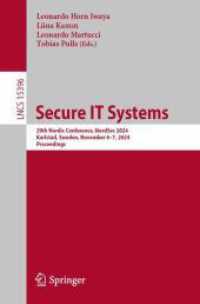- ホーム
- > 洋書
- > 英文書
- > Science / Mathematics
Full Description
Artificial intelligence (AI) techniques for rock tunnel construction offer innovative solutions for assessing rock mass quality and ensuring excavation safety in challenging geological conditions. Both cutting-edge contact methods and noncontact methods such as digital photography can provide continuous geological data during excavation. Then, advanced deep learning algorithms for precise characterization of rock face features, along with pioneering multisource 3D data fusion modelling, can enable refined rock mass classification and sophisticated safety evaluation techniques tailored to complex geological environments.
By integrating machine vision and intelligent algorithms with rigorous statistical analysis and machine learning models, this book provides practical and refined solutions for the construction industry. It offers improved safety, efficiency, and reliability for tunnel projects and serves as a valuable reference for graduate students and academics.
Contents
1. Introduction 2. Rock Mass Data Acquisition and Classification using Digital Photography 3. Automated Classification of Rock Mass Structural Features 4. Extraction and Quantitative Characterization of Weak Interlayers 5. Characterization of Groundwater Inflow 6. Extraction and Handling of Data on Joint Fractures 7. Characterization of Three-Dimensional Discontinuities and Traces 8. Intelligent Rock Mass Classification from Data Fusion 9. Tunnel Excavation Safety Assessment Based on Machine Vision and 3DEC Simulation 10. Conclusion and Outlook






